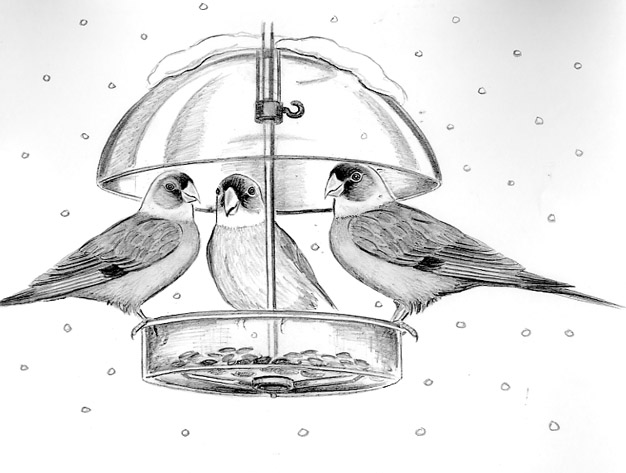
Dear Bird Folks,
I recently saw a display of very colorful birds that were labeled as “Carolina Parakeets.” I had never heard of them. The label also said that these birds were extinct. How sad. How long ago did they live? Were they ever found in my area? Why did they disappear?
– Judy, Hazleton, PA
Come on, Judy,
I’m not one to gripe about a bird question, especially one that doesn’t include a complaint about squirrels, but your timing could have been a little better. With only a few weeks to go until Christmas the last thing I want to write about is extinction. Talk about a downer. Wouldn’t you rather ask about French hens, turtle doves, or some other bird that’s a little more Christmassy? Okay, fine. Extinction it is. Just let me get a mug of eggnog first. That will help me get through it.
I don’t think you are alone, Judy. I would bet that very few people in Hazleton, or in any American town, including towns in Carolina, know much about the Carolina Parakeet. For such a distinctive bird it really hasn’t gotten much press. When it comes to extinct birds, most attention has been given to the shocking extermination of the Passenger Pigeon, a bird with a population that once was in the billions. Although the Carolina Parakeet may not have numbered in the billions, it was an abundant bird. But being abundant wasn’t enough to save it from our missteps.
The well-marked Carolina Parakeet was the only native parrot to live in the continental United States. Like many parrots it was strikingly colorful, with a bright green body and an even brighter yellow head and red face. Carolina Parakeets were parrots in every sense of the word, except you didn’t have to go to the steamy tropics to see them. They flew wild and free from the Great Lakes to the Gulf Coast and from the Atlantic Ocean to the Rocky Mountains. This parrot lived and bred in the same forests that many of us walk today. It also did little or no migrating, which meant it had to deal with North America’s notorious nasty winters. And that’s long before global warming had chance to take the edge off.
So what happened to the Carolina Parakeets? Well, farmers weren’t big fans because the birds often liked to sample their crops. In fact, many of the less educated farmers had bumper stickers on their horse-drawn wagons that read: “Carolina Parakeets taste like chicken.” When the bumper stickers didn’t work, the farmers next turned to guns to solve the problem and thousands of these parrots were shot on sight. Hat manufacturers also blasted away at the birds because their colorful feathers looked swell on the heads of rich women.
In most situations it would be hard to kill so many bird with bullets alone, but Carolina Parakeets had a quirky behavior that led to their rapid undoing. While most birds will totally flee at the sound of a gun, these parrots would return to the scene of the crime if some members of the flock weren’t able to make a clean getaway. All a gunner had to do was hit a bird or two and the entire flock would return to try and “help” their wounded comrades. After that…well, you can guess what happened after that.
Guns weren’t the Carolina Parakeets only problem. These were birds of the forest and much our nation’s forests were cleared for agriculture, building material and firewood. Some researchers also speculate that many parrots were lost to diseases contracted from domestic fowl. The birds also had a big problem from an unlikely source, honeybees. Carolina Parakeets needed natural tree cavities in which to build their nests. Without cavities the birds couldn’t successfully reproduce. (Unfortunately for the parrots there weren’t any fabulous birding stores selling birdhouses back then.) The introduced honeybees also used tree cavities to build their hives in. Often when the birds tried to enter a cavity, they were instantly confronted by a swarm of angry bees. Suddenly the farmer’s guns didn’t seem so bad.
Whatever the ultimate reason for decline of the Carolina Parakeet, it’s clear that the bird wasn’t able to hold on long enough for any kind of conservation movement to save it. The last documented wild flock disappeared in 1904 and the last captive bird, named “Inca,” died in the Cincinnati Zoo in 1918. A creepy footnote to all this is that Inca passed away in the same flight cage that “Martha,” the last living Passenger Pigeon, died in a few years earlier. Man, there must be some real bad karma going on with that cage.
The loss of the Carolina Parakeet is significant at many levels. Not only could its extinction have been prevented with just a little effort, but we also lost our only parrot. How cool would it have been to look out on a snowy Christmas morning to see a flock of brilliantly colored parrots eating away on our feeders? Few places in the world have a population of parrots that could handle cold weather, but we did…at least for a while.
I hope my answers about the Carolina Parakeets weren’t too much of a holiday bummer for you, Judy. Keep thinking good thoughts and you’ll feel better. And if that doesn’t work, then go grab a nice big mug of eggnog. It works for me every time.